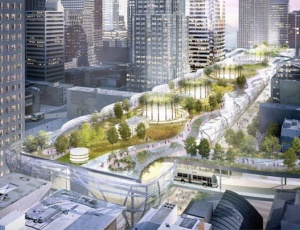The Transbay Joint Powers Authority reports that the official opening date of the Transbay Temporary Terminal and the closing of the existing Transbay Terminal will occur on Aug. 7, and at the same time work will start on the demolition of the existing terminal, which was built in 1939.

The Transbay Temporary Terminal, located on Howard and Main streets, will serve as the temporary bus facility until the completion of the new Transbay Transit Center at First and Mission streets in 2017.
According to the TJPA, Livermore-based Evans Brothers is the demolition contractor, a joint venture of Webcor/Obayashi is the general contractor for the new transit center construction and Turner is the construction manager.
The Transbay Temporary Terminal will serve AC Transit, Muni, Greyhound, WestCAT Lynx, Greyhound, SamTrans and Golden Gate Transit.
�We are very excited about the opening of the temporary terminal as it allows us to move forward with constructing what will be one of the first high speed rail stations in the country,� says Maria Ayerdi-Kaplan, executive director of the TJPA.
Principals involved in the temporary terminal construction project were McGuire Hester of Oakland, general contractor; Townsend Management Inc. of San Francisco, construction manager; and the Oakland office of Jacobs Carter Burgess, engineering/consulting. Besides the bus terminal, the temporary terminal will include an AC Transit site office, a customer service/security building, public amenities (canopies, seating, lighting, restrooms, bike racks, etc.) and driver restrooms.
The Transbay Transit Center project will replace the transbay terminal located at First and Mission streets and create a new, multi-modal transit center that will eventually serve more than 100,000 passengers per day.
Designed by Pelli Clarke Pelli, the Transbay Transit Center project will transform the area surrounding the new transit center into a new mixed-use neighborhood that will include 2,600 new homes (35% affordable), shops, public parks and plazas, widened sidewalks with new street trees and lights, and commercial space next to the new transit center.
The block of downtown San Francisco that will be occupied by the temporary terminal will, at the end of the project, be transformed into 732 new residential units and a one-acre public park. Folsom Street, the southern boundary of the temporary terminal, will emerge as the centerpiece of the new Transbay Neighborhood with widened sidewalks, cafes, markets and views of the San Francisco Bay.
The new transit center will display an iconic glass-and-steel structure that will serve 12 transit systems, including Caltrain and future California High Speed Rail. Designed to be the focal point of a new transit-oriented neighborhood, the transit center will be a destination for both transit users and the general public. The second phase of the project, scheduled for completion later this decade, will provide rail access to the new Transit Center via an underground tunnel from the existing rail terminal at 4th and King Streets.
One of the highlights of the new Transit Center is the 5.4-acre rooftop urban park. The park will feature an outdoor amphitheatre for musical performances, space for evening film screenings, cafes and restaurants. The park will contain some 20 sub-environments including the amphitheatre, a children�s playground, public artworks and a lily pond, providing rich educational and recreational experiences to the public.
The Transit Center is also slated to be among the greenest buildings in the U.S. and will meet the current LEED gold level standards. Some of its sustainable features include a geothermal system to assist in substantially reducing energy consumption and a greywater recycling system that will manage and re-use waste water in the facility. The transit center will be entirely naturally ventilated, and, to a large extent, naturally lit. The 5-acre park on the roof will contribute not only to the sustainability of the center by acting as a �living roof,� but will also enhance the quality of the environment for neighboring buildings.

Post a comment to this article
Report Abusive Comment